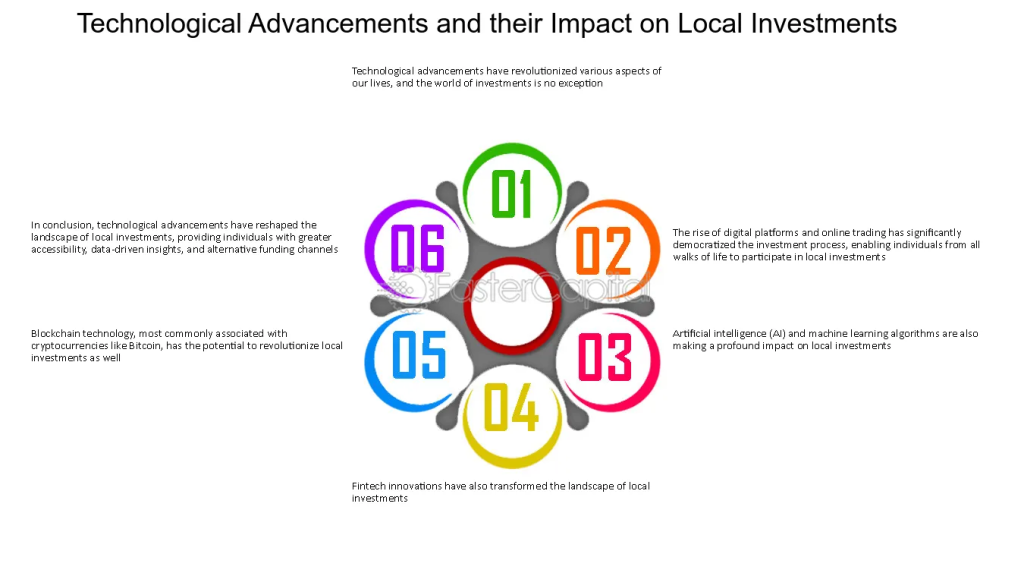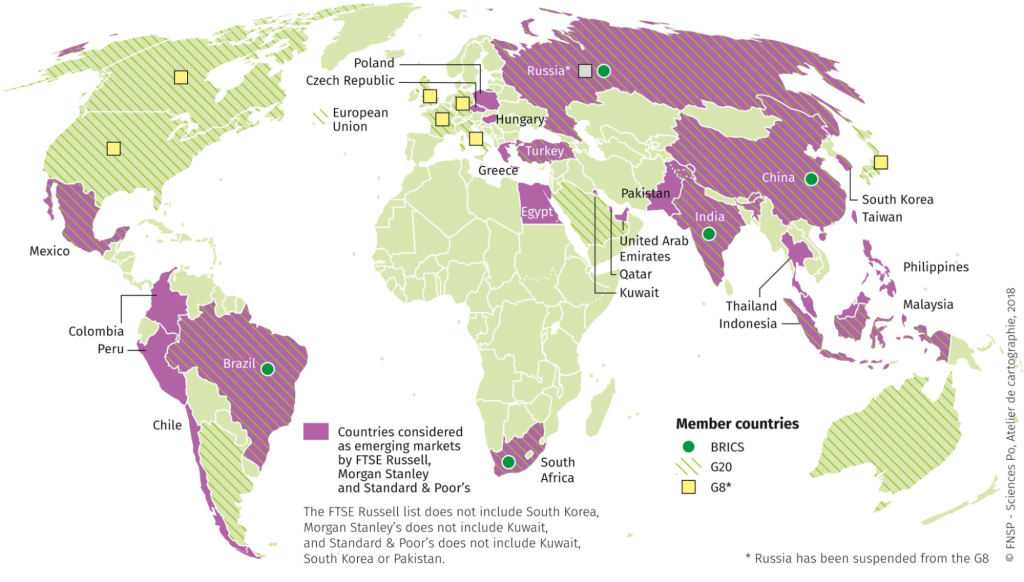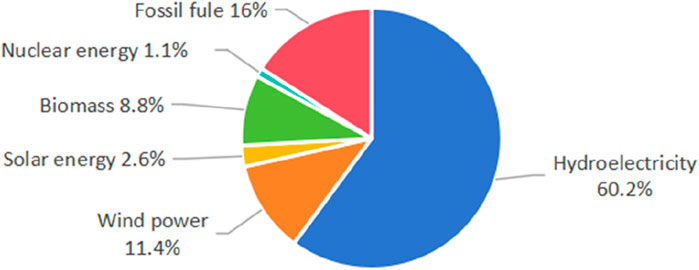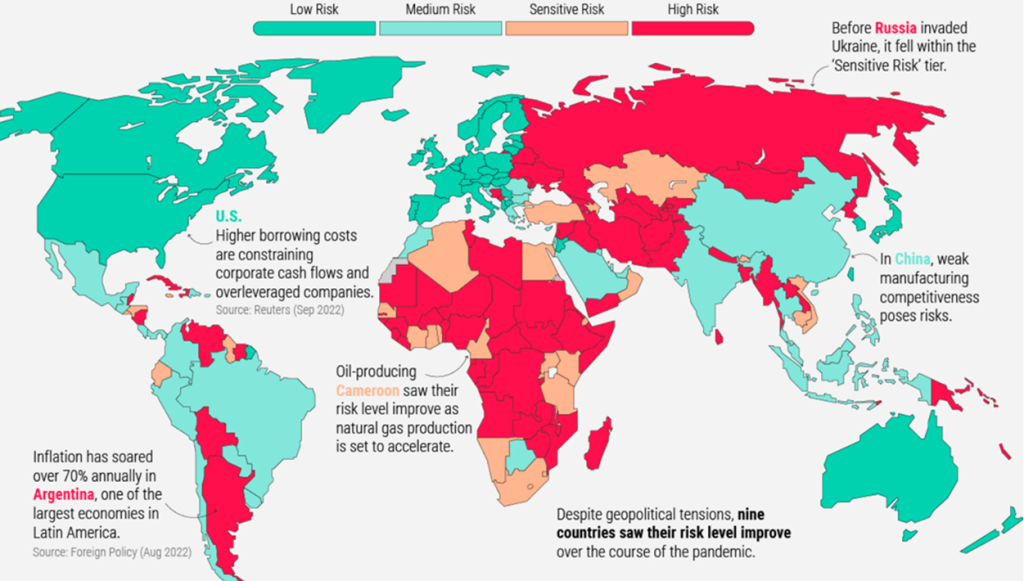グローバル:国際市場への投資
レッスンの学習目標:
- Familiarity with local market conditions: Grasp the significance of understanding economic and political environments in domestic markets, which can lead to more accurate and profitable investment decisions.
- 通貨の安定性: Learn about the advantages of reduced currency risk in domestic investments, which helps maintain financial stability and predictability.
- Technological impact on investments: Understand how technological advancements like digital platforms and blockchain are revolutionizing the investment landscape, offering new opportunities and tools for investors.
A. Benefits of Investing in Domestic Markets
Investing in domestic markets allows investors to leverage their familiarity with local economic conditions, businesses, and regulations. Domestic investors often have an advantage in understanding their local markets, enabling better-informed investment decisions. In addition, investing in local markets reduces 通貨リスク, as there is no need to exchange foreign currencies. Local investors also benefit from greater knowledge of domestic policies, tax incentives, and market dynamics.
- Familiarity with Local Market Conditions: Investors understand local economic and political environments.
- Currency Stability: Domestic investments avoid the risk of currency exchange fluctuations.

形: Technological Advancements and their Impact on Local Investments
説明:
This infographic illustrates how technological advancements have reshaped local investment landscapes. It identifies six key elements impacting local investments, each represented by a numbered segment. The elements include: the rise of digital platforms, artificial intelligence, fintech innovations, blockchain technology, data-driven insights, and alternative funding channels. These advancements have increased accessibility, democratized investment processes, and enabled new ways of funding and decision-making.
重要なポイント:
- Digital platforms have democratized investment opportunities, making them accessible to a broader audience.
- AI and machine learning are transforming investment strategies through enhanced analytics and decision-making.
- Fintech innovations provide new tools and services, changing traditional investment approaches.
- Blockchain technology introduces security and transparency, revolutionizing the transaction process.
- Data-driven insights allow for more informed and strategic investment decisions.
- Alternative funding channels offer diverse avenues for local investments, increasing participation.
情報の応用:
Understanding the role of technology in investments helps investors identify new opportunities and methods to maximize returns. It is essential for individuals to leverage digital tools, AI-powered analytics、 そして blockchain technologies to make more informed and diversified investment decisions. These insights also highlight the growing need for adapting to fintech advancements to remain competitive in the investment landscape.
B. Benefits of Investing in International Markets
Investing internationally allows investors to access global growth opportunities that may not be available in their home country. By diversifying across different regions, investors can benefit from industries and sectors that are not well-represented in domestic markets. For example, while an investor in Europe may have limited exposure to the technology sector, they can invest in U.S. tech stocks for growth. International investments also provide a hedge against local economic downturns, as other regions may be experiencing economic expansion.
- 多様化: International investments spread risk across different markets, reducing overall portfolio risk.
- Access to High-Growth Markets: International markets, particularly emerging economies, offer potential for higher returns compared to more mature domestic markets.

形: Emerging Markets and Member Countries of BRICS, G20, and G8 (2018)
説明:
This map displays countries classified as emerging markets according to FTSE Russell, Morgan Stanley, and Standard & Poor’s. The countries marked in purple are identified as emerging markets, while colored circles and patterns denote memberships in international groups: BRICS (green circles), G20 (green stripes), and G8 (yellow squares). Russia, though suspended from the G8, is highlighted. Key regions covered include Latin America, Asia, Eastern Europe, and parts of Africa and the Middle East.
重要なポイント:
- Emerging markets are identified across various continents, reflecting global economic diversity.
- BRICS countries (Brazil, Russia, India, China, South Africa) are central to emerging markets.
- G20 countries also overlap with emerging markets, representing significant global economic players.
- G8 members are traditionally advanced economies, but Russia is still included despite its suspension.
情報の応用:
This map helps investors understand the global distribution of emerging markets and the role of international groups like BRICS, G20, and G8 in shaping economic strategies. It provides context for evaluating potential investment opportunities and geopolitical influences in global markets. Understanding emerging market classification aids in diversifying portfolios and recognizing regions with growth potential.
C. Risks of Investing in Domestic Markets
While domestic markets provide stability and familiarity, they also come with risks, particularly during periods of economic downturns or political instability. Domestic markets can become overexposed to specific industries, limiting diversification. For example, an investor in a country reliant on a single industry (like oil or manufacturing) may experience significant losses if that industry declines.
- Overexposure to Domestic Sectors: Limited diversification can result in significant losses if the dominant sectors in a domestic market underperform.
- Political Risks: Domestic investments are exposed to local political changes and economic policy shifts.

Figure: : Energy Sources Distribution (2024)
説明:
This pie chart illustrates the percentage share of different energy sources in 2024. The majority of energy comes from Hydroelectricity, accounting for 60.2% of the total share. Other significant sources include Fossil fuels (16%), Wind power (11.4%)、 そして Biomass (8.8%). Solar energy represents 2.6%, while Nuclear energy is the least utilized source, contributing only 1.1%.
重要なポイント:
- Hydroelectricity is the dominant energy source, contributing over half of the total energy supply.
- Fossil fuels remain a significant part of the energy mix, though less than Hydroelectricity.
- Renewable sources、 のような Wind power, Biomass, and Solar energy, are growing components, with Wind power leading among them.
- Nuclear energy has a minimal presence in the energy mix.
情報の応用:
This data is useful for understanding the current energy landscape and the role of renewable energy sources in reducing carbon emissions. It highlights the importance of hydropower in sustainable energy production while showing potential areas for growth in solar and wind energy. Investors and policymakers can use this information to guide 投資決定 そして energy policy planning, focusing on expanding renewable sources to achieve a balanced and sustainable energy portfolio.
D. Risks of Investing in International Markets
While domestic markets provide stability and familiarity, they also come with risks, particularly during periods of economic downturns or political instability. Domestic markets can become overexposed to specific industries, limiting diversification. For example, an investor in a country reliant on a single industry (like oil or manufacturing) may experience significant losses if that industry declines.
- Overexposure to Domestic Sectors: Limited diversification can result in significant losses if the dominant sectors in a domestic market underperform.
- Political Risks: Domestic investments are exposed to local political changes and economic policy shifts.

形: 国際市場拡大戦略
説明:
This image portrays a hand holding a digital representation of the Earth surrounded by various global currency symbols, such as USD ($), Euro (€), Pound (£), Yen (¥), and more. The globe symbolizes international financial markets and global connectivity. The image emphasizes the concept of financial integration, digital transactions, and the interconnected nature of global economies, highlighting how various currencies are part of a cohesive international financial system.
重要なポイント:
- の hand signifies human involvement in managing global finances, indicating the need for strategic planning and control in international markets.
- の floating currency symbols represent the diversity of global currencies and the complexity of international finance.
- の digital globe emphasizes the digital nature of modern finance, with technology facilitating global transactions.
情報の応用:
This image can help learners understand the concept of global finance and the importance of diverse currencies in international trade and investment. It highlights the need for digital tools and strategic insights to manage cross-border transactions and investments effectively. For investors, it emphasizes the significance of understanding currency exchange rates そして global market trends when participating in international markets.
- Currency Risk: Changes in foreign exchange rates can negatively impact the value of international investments.
- Political Instability: Geopolitical risks and regulatory changes in foreign markets can lead to uncertainty and volatility.

形: Global Macroeconomic Risk Map (2022)
説明:
This map illustrates the macroeconomic risk levels across different countries worldwide in 2022. It categorizes countries into low, medium, sensitive, and high risk tiers, represented by varying colors from green (low risk) to red (high risk). Key insights include higher borrowing costs in the U.S., inflation in Argentina, geopolitical tensions in Russia affecting risk levels, and improvements in Cameroon’s natural gas production. China is highlighted for its weak manufacturing competitiveness.
重要なポイント:
- Higher borrowing costs in the U.S. have strained corporate cash flows and overleveraged companies.
- Inflation in Argentina soared over 70%, signaling high economic vulnerability.
- Cameroon’s natural gas production contributed to improved risk levels.
- Russia’s invasion of Ukraine heightened the country’s risk from the “sensitive” tier to “high risk.”
- China faces challenges due to weak manufacturing competitiveness, impacting its risk rating.
情報の応用:
理解する macroeconomic risk map helps investors identify potential challenges and opportunities in global markets. It emphasizes the need to assess country-specific risks when considering international investments. This knowledge can guide strategic decisions, especially when evaluating 新興市場 or regions with volatile economic conditions.
主なレッスン情報:
- Local knowledge offers a strategic advantage, enabling investors to anticipate market trends and regulatory changes more effectively.
- Currency stability protects investments from the volatility of foreign exchange, providing a more secure investment environment.
- Technological advancements such as AI and fintech innovations are transforming how investments are made, offering more precise analytics and streamlined processes.
閉会の辞:
By investing domestically, individuals can leverage their knowledge of local markets to make informed decisions, reduce currency risks, and capitalize on technological advancements, enhancing their overall investment strategy.

